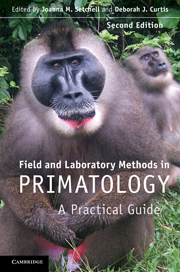Book contents
- Frontmatter
- Contents
- List of contributors
- Foreword by Robert D. Martin
- Introduction
- 1 An ethnoprimatological approach to interactions between human and non-human primates
- 2 Habituating primates: processes, techniques, variables and ethics
- 3 Habitat description and phenology
- 4 Geographical information systems and remote sensing
- 5 Monitoring local weather and climate
- 6 Survey and census methods: population distribution and density
- 7 Trapping primates
- 8 Handling, anaesthesia, health evaluation and biological sampling
- 9 Morphology, morphometrics and taxonomy
- 10 Marking and radio-tracking primates
- 11 Field experiments with non-human primates: a tutorial
- 12 Feeding ecology, frugivory and seed dispersal
- 13 Dietary analysis I: food physics
- 14 Dietary analysis II: food chemistry
- 15 Collecting arthropods and arthropod remains for primate studies
- 16 Recording primate vocalizations
- 17 Photography and video for field researchers
- 18 Chronobiological aspects of primate research
- 19 Thermoregulation and energetics
- 20 Field endocrinology: monitoring hormonal changes in free-ranging primates
- 21 Collection, storage and analysis of non-invasive genetic material in primate biology
- 22 Tips from the bush: an A–Z of suggestions for successful fieldwork
- Index
- References
19 - Thermoregulation and energetics
Published online by Cambridge University Press: 05 June 2012
- Frontmatter
- Contents
- List of contributors
- Foreword by Robert D. Martin
- Introduction
- 1 An ethnoprimatological approach to interactions between human and non-human primates
- 2 Habituating primates: processes, techniques, variables and ethics
- 3 Habitat description and phenology
- 4 Geographical information systems and remote sensing
- 5 Monitoring local weather and climate
- 6 Survey and census methods: population distribution and density
- 7 Trapping primates
- 8 Handling, anaesthesia, health evaluation and biological sampling
- 9 Morphology, morphometrics and taxonomy
- 10 Marking and radio-tracking primates
- 11 Field experiments with non-human primates: a tutorial
- 12 Feeding ecology, frugivory and seed dispersal
- 13 Dietary analysis I: food physics
- 14 Dietary analysis II: food chemistry
- 15 Collecting arthropods and arthropod remains for primate studies
- 16 Recording primate vocalizations
- 17 Photography and video for field researchers
- 18 Chronobiological aspects of primate research
- 19 Thermoregulation and energetics
- 20 Field endocrinology: monitoring hormonal changes in free-ranging primates
- 21 Collection, storage and analysis of non-invasive genetic material in primate biology
- 22 Tips from the bush: an A–Z of suggestions for successful fieldwork
- Index
- References
Summary
INTRODUCTION
The study of how animals apportion time and energy (energetics) can provide much insight into physiology, ecology and evolution (Bartholomew, 1982; Geiser, 2004; Schmidt-Nielsen, 1997). Body temperature has a profound effect on the ability of animals to function effectively. Since all animals generate heat internally to some extent, energetics is closely linked to the problem of heat management and thermoregulation. For example, homeothermic or ‘warm-blooded’ animals (birds and mammals) must produce a great amount of heat in order to maintain a high and constant body temperature in cold as well as in warm surroundings (Schmidt-Nielsen, 1997). Moreover, natural environments can be extremely variable in their thermal attributes and consequently animals show behavioural and physiological adaptations that enable them to cope with these external gradients.
Over the past decade, there has been a tremendous increase in methodologies and techniques applicable to studies of energy expenditure and thermoregulation. This is particularly true for the study of daily energy requirements and body temperature rhythms of wild animals behaving normally in their natural habitats. In this contribution, I therefore review methods for the study of energetics and mechanisms of temperature regulation in primates (although these can generally be applied to almost all mammal species). I also briefly mention other possibilities for physiological measurements. All procedures described here require capture of the study animals, and some require invasive surgical intervention. They therefore raise ethical questions when dealing with wild animals and/or endangered species, and require governmental permits and authorization.
- Type
- Chapter
- Information
- Field and Laboratory Methods in PrimatologyA Practical Guide, pp. 339 - 352Publisher: Cambridge University PressPrint publication year: 2011
References
- 1
- Cited by



